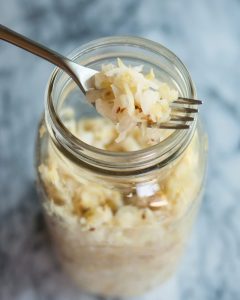Sauerkraut is a type of fermented cabbage with major health benefits for both your immune system and gut health.
Due to the fermentation it undergoes, sauerkraut offers nutrition and health benefits far beyond those of fresh cabbage. The range of micronutrients that it offers includes;
- Sodium
- Vitamin C
- Vitamin K1
- Iron
- Magnesium
- Vitamin B6
- Folate
- Copper
- Potassium
More on the Fermentation process…
In fermentation, a process during which microorganisms on the cabbage digest its natural sugars and convert them into carbon dioxide and organic acids. It is this that makes it so helpful to your gut and aiding in positive digestion.
Fermentation starts when yeast and bacteria that are naturally present on the cabbage and your hands, as well as in the air, come into contact with the sugars in the cabbage.
Sauerkraut fermentation creates conditions that promote the growth of beneficial probiotics, which are also found in products like yogurt and kefir.
Probiotics are bacteria that provide powerful health benefits. They also help make foods more digestible, which increases your gut’s ability to absorb the vitamins and minerals they contain.
However, unlike cabbage, sauerkraut can be high in sodium. Keep this in mind if you’re watching your salt intake.
8 OTHER Benefits of Sauerkraut:
-
Sauerkraut improves your digestion
-
Boosts your immune system
-
Improve gut health which positively impacts metabolic health
-
Helps reduce stress and maintain brain health
-
Contributes to stronger bones
-
Acts as an antioxidant for cell health
-
Helps to produce antibodies which will fight of infection
-
High in Vitamin C and iron
SUMMARY POINTSauerkraut is rich in fibre, vitamins, and minerals. Its probiotics also help your body absorb these nutrients more easily, which is what makes sauerkraut more nutritious than raw cabbage or coleslaw.
TIPS WHEN BUYING SAUERKRAUT
You can find sauerkraut easily in most supermarkets, but not all types you’ll come across will be the same.
To ensure you get the most out of store-bought sauerkraut, try to keep these simple tips in mind:
- Avoid pasteurized varieties. Off-the-shelf sauerkraut is typically pasteurized, a process that kills the beneficial probiotics. Refrigerated varieties are less likely to be pasteurized, but check the label to be sure.
- Avoid preservatives. Many store-bought sauerkraut brands contain preservatives, which may lower the probiotic count.
- Avoid added sugars. Sauerkraut should only contain two basic ingredients: cabbage and salt. Some varieties may also add extra vegetables, but avoid those that add sugar or anything else to the mix.
RECIPE: Basic Sauerkraut

Ingredients
- 1 medium green cabbage
- 1 tablespoon (15 mL) of non-iodized salt
- 2–3 carrots, shredded (optional)
- 2–3 cloves garlic, finely chopped (optional)
Have a 1-litre jar ready to keep the sauerkraut in, a smaller jar to press it down, and a kitchen scale to weigh your cabbage mixture.
Directions
- If you wish to add carrots and garlic, start by placing them in a large bowl.
- Discard the outer leaves of your cabbage, setting one nicer leaf aside. Then, slice the cabbage into quarters, leaving the core in. This makes shredding easier.
- Shred the cabbage quarters into the large bowl with the carrot and garlic mix. Incorporate enough cabbage to bring the total weight up to 800 grams, which will fit a 1 litre jar.
- Add salt and massage it into the cabbage mixture for a few minutes until brine starts accumulating at the bottom of your bowl.
- Pack the cabbage mixture into a clean 1-liter jar, pressing down to get rid of air pockets. Pour the remaining brine into the jar. Air in the jar enables harmful bacteria to grow, so make sure the mixture is completely submerged.
- Trim the cabbage leaf you set aside earlier to the size of your jar opening. Place it in the jar on top of the mixture to prevent veggies from floating to the surface.
- Place a smaller jar with no lid inside the larger jar, on top of the mixture. This will hold your veggie mixture below the brine during fermentation.
- Screw the lid onto your larger jar. It will press the smaller jar down, keeping your cabbage mixture below the brine. Leave the lid slightly loose, which will allow gases to escape during the fermentation process.
- Keep it at room temperature and out of direct sunlight for 1–4 weeks.
Keep in mind that the larger the head of cabbage you start with, the sweeter and better your sauerkraut will taste.
If you’re impatient to taste your creation, you can do so after 7 days. The longer you allow it to ferment, the stronger the taste will be.






